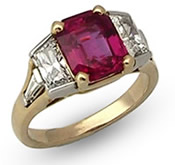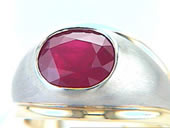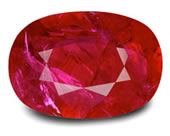 Will
the Real Ruby Please Stand Up
Will
the Real Ruby Please Stand Up
Treatments, origin, and color determine the value of ruby — and maybe whether it even IS ruby.
TREATMENTS
Gem treatments, or enhancements, improve the stone’s appearance. Some treatments are innocuous, others are attempts to conceal flaws in a lower-quality stone. Here’s what to look for on the appraisal when insuring rubies.
- Heat
Most rubies are subjected to heat to improve their color. This is the only treatment considered “usual” practice for rubies. If the stone has not been heated, that should appear on the appraisal. A ruby that is not heat-treated is more valuable than one of similar appearance that has been heated. - Fracture Filling
Fracture filling is an attempt to disguise a flaw in the stone. Long a common practice with low-quality diamond and emerald, it is now being done to ruby as well. Four major gem laboratories have sent out industry alerts regarding fractured rubies with lead-glass filler.
Many rubies currently on the market come from mines that produce what one
expert describes as “ugly duckling” stones, gems with a multitude
of surface-breaking fractures. A common way to heal the cracks is to inject
a chemical that helps melt the surface of the stone. A mix of the flux and
surrounding ruby material then flows into the fracture and seals it.
The treatment is permanent and the repaired ruby is stronger than if it had
been left untreated. However, one gemologist thinks fracture filling “represents
open-heart surgery, not just a haircut.” The stone has been drastically
altered. Dealers admit that the highly fractured rubies would not be suitable
for jewelry without this treatment.
What’s important here—for the insurer and the consumer—is that the treatment be disclosed. A ruby that has been fracture-filled is worth less than an untreated ruby of similar appearance; it is, after all, a low-quality stone with its cracks filled in.
ORIGIN
Large flawless rubies are scarce and costly. Burma ruby, mined in the Mogok area of Myanmar, is considered the rarest and most valuable of fine gem quality ruby. High-value rubies from Burma or Ceylon will have their origin on the appraisal.
More moderately priced rubies from other sources are generally not identified by country of origin.
Synthetic Rubies
A ruby’s origin might, of course, be the lab. Synthetic rubies are quite common and easily identified by a competent jeweler. A synthetic ruby should be so identified on the appraisal.
COLOR
Ruby’s name is from the Latin word rubinus, meaning red. Its gem species, corundum, comes in a spectrum of colors. Four specific hues of corundum are classed as ruby, all the other colors being sapphire. (See Secrets of Sapphire for more discussion of corundum and sapphire.)
Since ruby is red by definition, a description of its specific color is crucial to valuation. On the appraisal, this description should be given in the precise gemological language of tone, saturation and hue. For example, a ruby’s color might be described as
medium dark (tone), vivid (saturation) purplish Red (hue).
Proper color identification is also what distinguishes ruby from pink sapphire. Since ruby is generally worth significantly more than sapphire, it’s important that a gem being insured and priced as ruby be, indeed, ruby.
Most jewelers are not sufficiently trained in gemology, or sufficiently experienced in dealing with colored gems, to adequately describe colored gems. Be sure an appraisal for colored-gem jewelry comes from a graduate gemologist who is also a Certified Insurance Appraiser and who has experience in buying and selling colored gems.
FOR AGENTS AND UNDERWRITERS
About 50% of ruby’s valuation comes from its color. Be sure the appraisal describes color in the gemologist’s terms of tone, saturation and hue.
Synthetic rubies are quite common. The appraisal should state that the gem is either natural or synthetic, since synthetic gems are worth considerably less than natural.
Any treatments, especially fracture filling, should be listed. Or the appraisal should state that the gem is untreated.
Use ACORD 18 Jewelry Appraisal and Claim Evaluation to be sure all necessary information is on the appraisal. If crucial information is missing, recommend that the policyholder get an appraisal on ACORD 78/79 or ACORD 805.
FOR ADJUSTERS
Synthetic rubies are worth much less than natural. Check the appraisal for the word synthetic.
Fracture-filled rubies are penetrating the marketplace and may be passed off as untreated gems. Check the appraisal for the terms fracture-filled, treated, and clarity-enhanced.
Always have damaged stones examined by a gemologist (who is not the selling jeweler) before settling a claim. For rubies, and all colored gems, be sure to consult a jeweler who regularly deals with colored gemstones. The jeweler should also be a graduate gemologist and a Certified Insurance Appraiser™.
©2000-2025, JCRS Inland Marine Solutions, Inc. All Rights Reserved. www.jcrs.com



